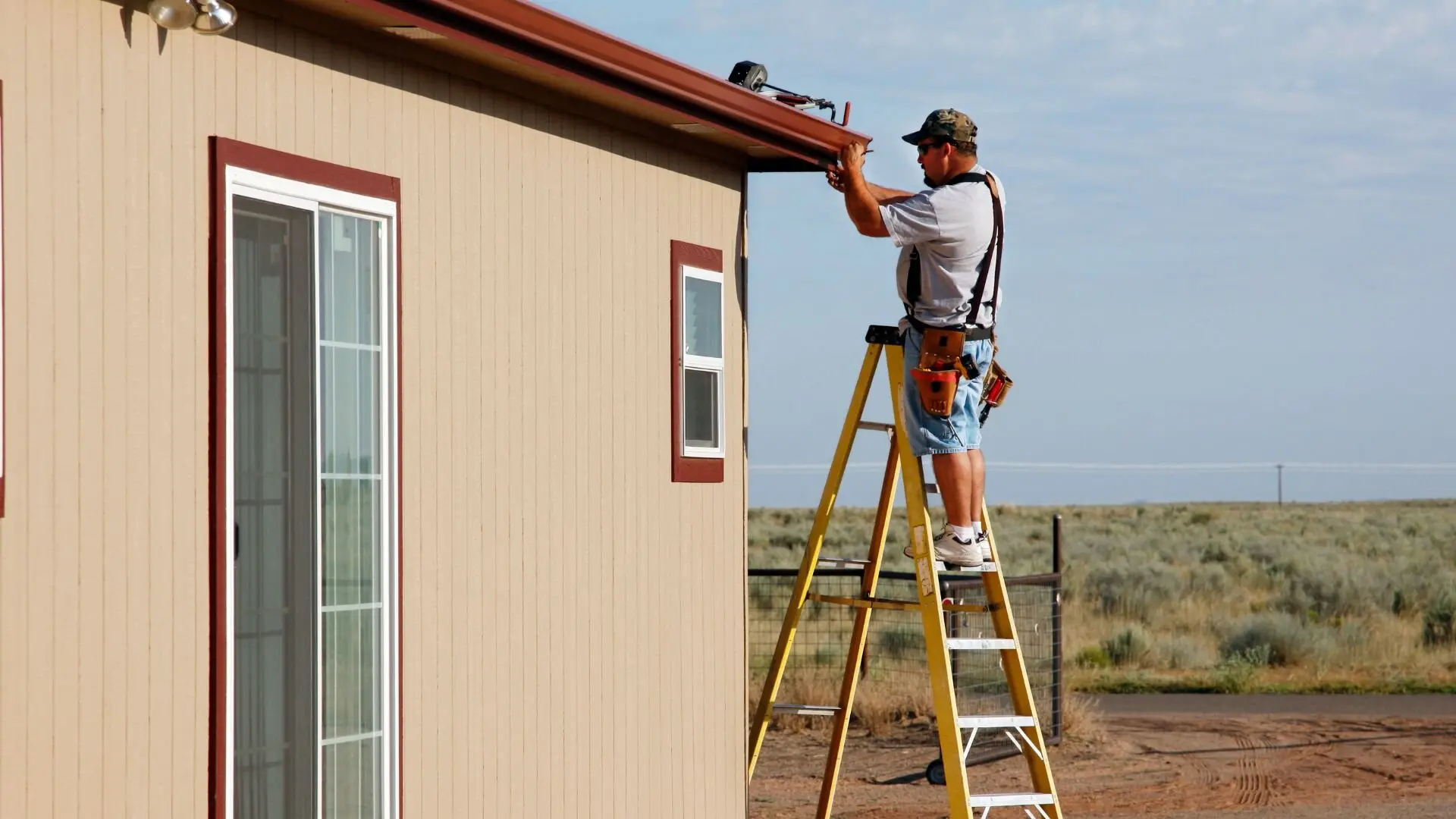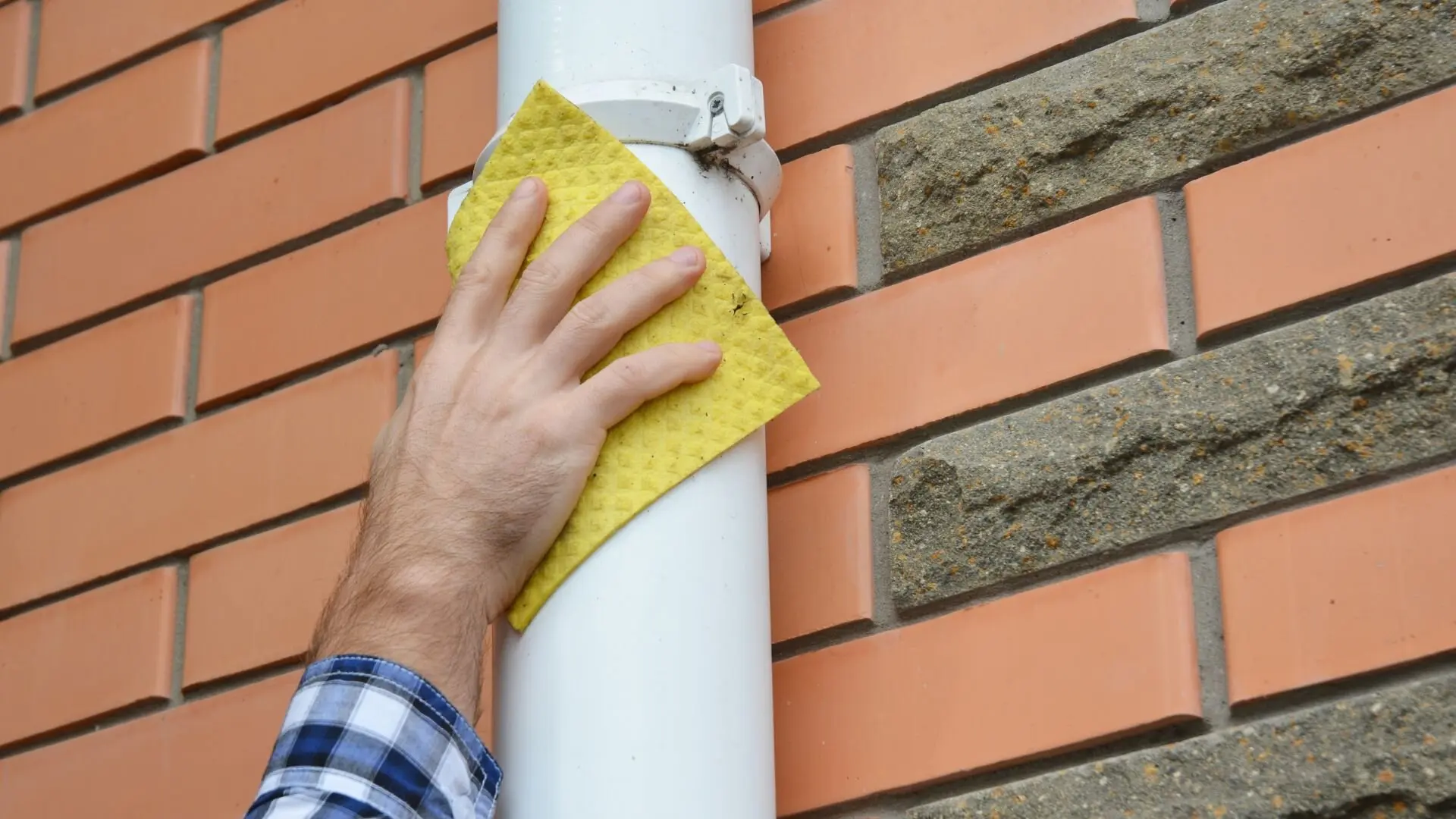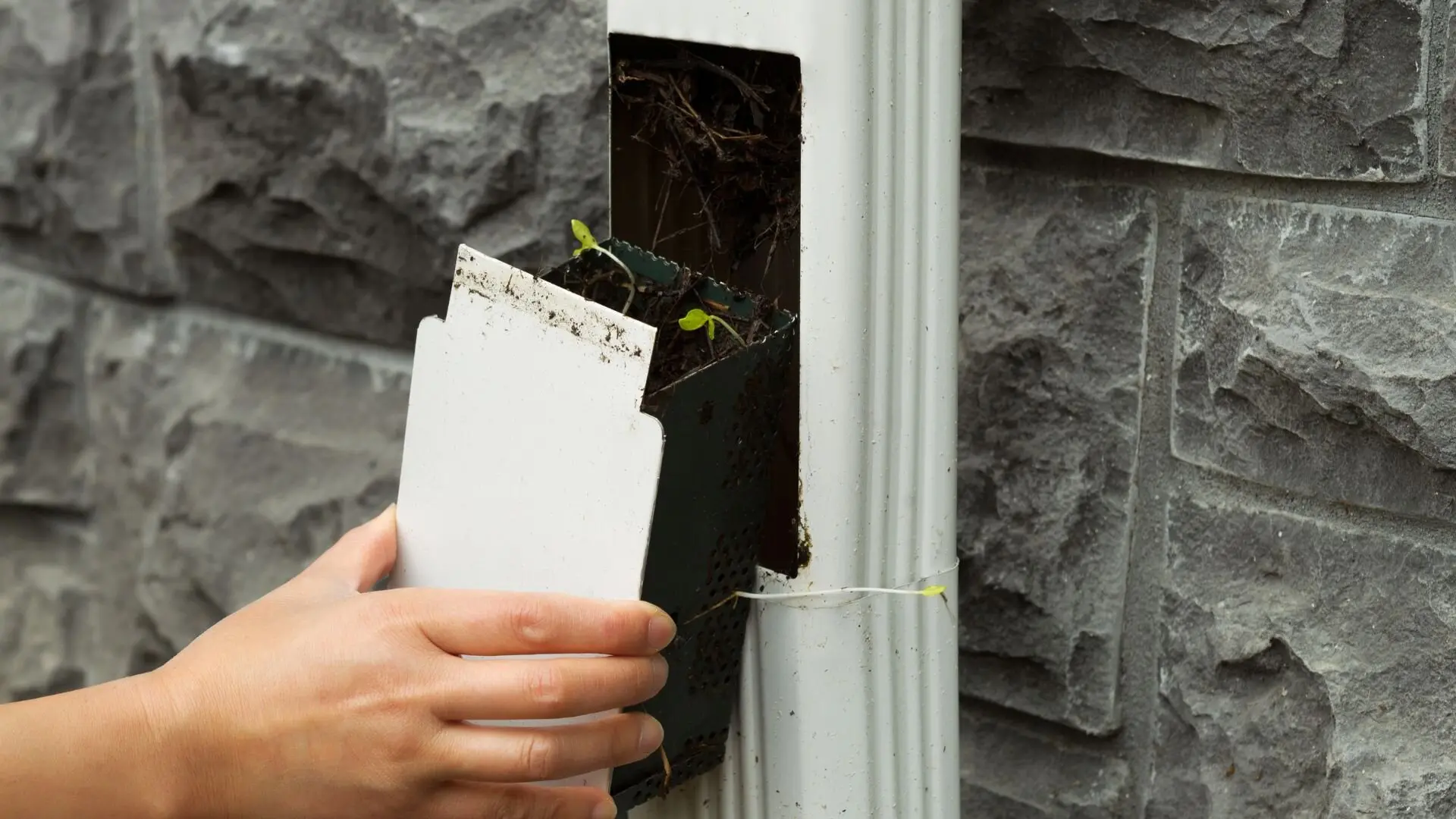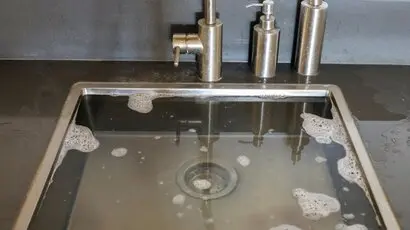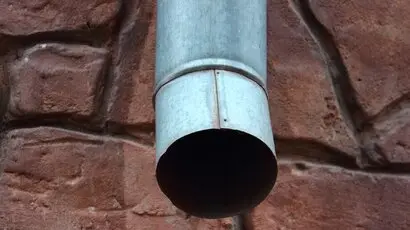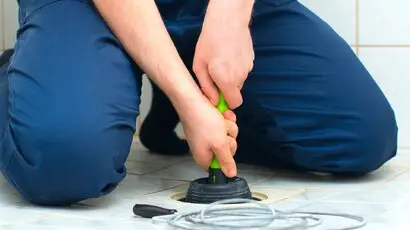Ever come home after a heavy storm to find water cascading down your walls? It’s a nightmare scenario, and often, the culprit is a blocked downpipe. These crucial components of your home’s drainage system silently work hard to channel rainwater away from your roof and into stormwater drains. But when blocked with leaves, twigs, and other debris, they can cause serious problems.
Blocked downpipes can lead to overflowing gutters. This overflow can then cause water damage to your roof, walls, and even your home’s foundation. These repairs can be expensive and time-consuming, adding unnecessary stress to a situation.
Fortunately, you can sidestep these hassles with some simple preventative maintenance. Regular cleaning of your gutters and downpipes is essential, and installing gutter guards can help keep debris at bay.
In this blog, we’ll delve into all things gutter downpipe maintenance. From the best cleaning techniques to strategies for avoiding blockages, and even the upsides of rainwater harvesting, you’ll find it all here. Turn a potential issue into a handy resource for your garden.
So, ensure your gutters and downpipes are clear to steer clear of stormwater woes! For tips, check out how to clear your gutters at home.
Understanding Downpipes and Blockages
Your downpipes play a critical role in your home’s drainage system. These vertical pipes act as an essential pathway, channelling rainwater collected in your roof gutters away from your house and into stormwater drains. They ensure a smooth flow of water, protecting your property from potential damage. However, downpipes can become blocked by various culprits. Leaves, twigs, and other debris carried by wind can easily accumulate inside the pipes, restricting water flow. Nesting animals seeking shelter can also contribute to blockages by building their homes within the downpipes.
![]()
So, how do you know if your downpipe is blocked? There are a few telltale signs to watch out for. Overflowing gutters are a clear indication that water isn’t draining properly. You might also notice water pooling around the base of your house, which can lead to serious foundation problems if left unchecked.
Keeping up with regular maintenance is crucial to ward off downpipe blockages. By cleaning your gutters and downpipes routinely, you can get rid of leaves, twigs, and other debris before they build up and block water flow. Adding gutter guards provides an extra shield, keeping debris out of your gutters from the get-go.
If you suspect a blocked downpipe, there are a few ways to tackle it yourself. In some cases, you might be able to clear the blockage with a simple garden hose flush. You can sometimes dislodge the blockage and restore water flow by hosing up the downpipe from below. However, for more stubborn blockages, you may need to use a downpipe cleaning tool or a plumber’s snake.
Here are some additional tips to keep your gutters and downpipes clear:
- Make sure your gutters are angled correctly to ensure proper water flow.
- Clean your gutters and downpipes at least twice a year or more often if you live in an area with a lot of trees.
- Look for signs of blocked stormwater drains around your property, as these can also cause downpipe backups.
If cleaning your gutters and downpipes isn’t your cup of tea or you’re facing a stubborn blockage, call in the pros. A qualified plumber can swiftly and safely clear your downpipes, ensuring your home’s drainage system is in top shape.
Keeping your gutters and downpipes clear is a smart move to prevent water damage, safeguard your home’s foundation, and steer clear of hefty repair bills. Don’t forget, if left unchecked, a blocked downpipe can cause water stains, damp spots, and even structural issues. By taking preventative steps and tackling blockages swiftly, you’ll keep your rainwater pipes and stormwater drainage system humming along smoothly.
Preventative Maintenance for Downpipes
Keeping your downpipes clear and functioning properly protects your home from water damage.
Schedule regular cleaning for your gutters and downpipes. The frequency will depend on the surrounding vegetation. In autumn, when leaves fall in abundance, cleaning may be needed more often—perhaps monthly. Spring cleaning is also crucial to remove debris accumulated over winter.
Safety is paramount when cleaning your gutters and downpipes. Always work from a sturdy ladder secured on level ground. Wear gloves and use appropriate tools to scoop out debris. If you’re uncomfortable working at heights, consider hiring a professional gutter cleaning service. They have the experience and equipment to safely and efficiently clean your entire drainage system, including unblocking downpipes if necessary.
![]()
Gutter guards act as a physical barrier against leaves, twigs, and other debris entering your gutters and downpipes. This significantly reduces the need for frequent cleaning and clearing of blocked downpipes. There are various types of gutter guards available, each with its own advantages:
- Mesh guards: These are constructed from fine metal mesh that allows water to pass through while blocking debris. They’re a good choice for most homes.
- Brush guards: These feature rows of bristles that filter out leaves and debris while allowing water to flow freely. They’re particularly effective in areas with heavy leaf fall.
- Foam guards: Made from lightweight foam, these guards sit inside the gutter and absorb debris. They’re a good option for areas with minimal leaf fall but may require more frequent replacement.
When choosing gutter guards, consider your roof pitch and the amount of debris in your area. Steeper roofs may require a different type of guard than flat roofs. Additionally, if you have a lot of trees surrounding your house, brush guards might be the most effective solution to prevent causes downpipe blockages.
Installing gutter guards yourself can be a DIY project, but safety precautions are crucial. As always, work from a secure ladder and ensure the guards fit snugly into your gutters for optimal performance.
Maintaining a safe distance between overhanging branches and your roof is vital. Leaves and twigs from nearby trees are a major cause of gutter and downpipe blockages. Consider consulting a qualified arborist for proper tree trimming techniques that promote healthy growth while minimising debris near your roofline. Additionally, keeping gardens and shrubs clear from the house helps reduce the amount of debris accumulating in your gutters and downpipes.
Additional Maintenance Tips
- Downpipe Flushing: Periodically flush your downpipes with a strong stream of water from your garden hose. This can help remove built-up sediment and ensure smooth water flow, preventing blockages.
- Leaf Screens and Filters: Leaf screens and filters offer alternative gutter protection methods. Leaf screens attach directly to the downpipe opening, while filters sit inside the downpipe itself, both catching debris before it enters the system and helps prevent blocked stormwater drains.
- Rainwater Tanks: Installing a rainwater tank can also reduce the flow of debris through your downpipes. As rainwater gets diverted into the tank, less debris reaches your drainage system, minimising the need for frequent cleaning and unblocking downpipes.
By following these preventative maintenance tips, you can keep your downpipes functioning properly and protect your home from water damage. Again, if you’re uncomfortable cleaning your gutters and downpipes yourself, consider hiring a professional service. They can also provide a free quote for gutter cleaning, gutter guard installation, or even roof restoration if water damage has already occurred.
Addressing Existing Blockages
![]()
Even with the best preventative measures, blockages can still occur in your downpipes. Don’t panic! Here are some basic troubleshooting tips you can try:
- Visual Inspection: First, check for any visible objects lodged in the top of your downpipe or gutter. Look for things like tennis balls, toys, or large branches that might be causing the blockage. You can often remove these by hand or with a grabbing tool.
- Hose Power: If you can’t see anything obvious, try using a garden hose to dislodge the blockage. Attach a high-pressure nozzle to your hose and feed it up the downpipe. The force of the water can often break up and clear away accumulated debris.
It’s important to remember that these are just basic solutions for minor blockages. If you’re dealing with a stubborn blockage or a situation that seems more complex, seeking professional help is the best course of action. A qualified plumber has the expertise and tools to safely and effectively clear your downpipes. They can also identify any underlying issues within your drainage system, preventing future problems.
Don’t wait until your home is facing potential water damage before addressing a blocked downpipe. By taking proactive steps, whether it’s preventative maintenance or seeking professional help for existing blockages, you can ensure your home’s drainage system functions optimally, protecting your property and saving you money in the long run.
Clear Downpipes, Clear Conscience
Just like a healthy heart keeps your body functioning smoothly, well-maintained downpipes are essential for a healthy home. Keeping your gutters and downpipes clear protects your property from water damage and potential foundation issues.
For expert advice or assistance with stubborn blockages, contact WP Plumbing. Our qualified plumbers can quickly clear your downpipes and ensure your drainage system is functioning optimally. We also offer free quotes and consultations, so don’t hesitate to get in touch!

